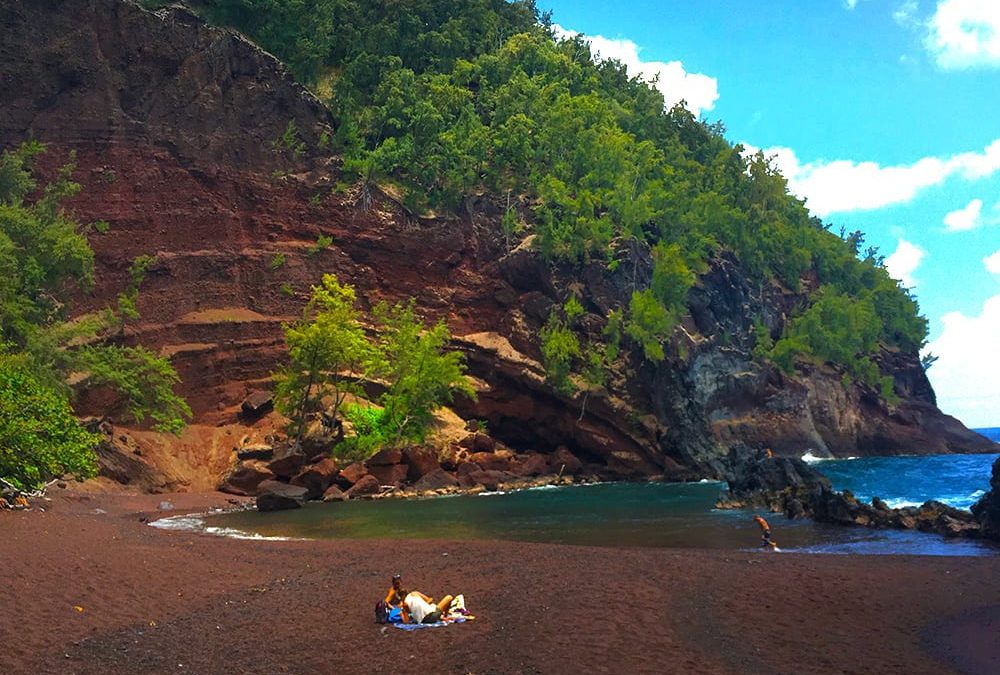Best Rainy Day Activities on Maui
While Wailea, Kihei, and Lahaina tend to be dry pretty much year-round, there are still days when it rains. Normally, the rains come in the form of sh...

Maui is blessed with the best beaches in the world. A unique thing about our beaches is the variety of sands you can discover. Here's a quick primer on three different types of sands and where you can find them on Maui. Plus, we'll point you to two more sands found on other islands.
Golden sand
Golden sands are the most common you'll find on Maui. Our beaches are primarily volcanic in origin. Mixed into this base is organically formed "sand" created by sloughed off dead corals, broken shells of sea creatures, minerals, and bio matter deposited by fish. When combined, the result is the golden sands found in Lahaina, Wailea, Kihei and most beaches around Maui.
Red sand
Kaihalulu Beach, located south of Hana Bay at the base Ka'uiki Head, is an excellent example of a rare, red sand beach. Ka'uiki head is a cindercone, rich with iron. As it erodes, this iron seeps onto the beach to give it a magnificent, deep red hue. To get to Kaihalulu Beach, you must traverse a fairly treacherous hiking trail. Unless you are accustomed to hiking and walking along steep ledges, you may want to steer clear.
Black sand
The nicest black sand beach on Maui is Wai'anapanapa State Park, located just off the Road to Hana. When volcanic lava meets the ocean, it rapidly cools and shatters. The smallest of the shattered debris becomes black sand. While black sand beaches can form in mere hours, without an ongoing source of lava, they can also quickly disappear. Since Wai'anapanapa was formed by a now dormant volcano, the black sand you see on the beach is all the black sand you'll ever see here. Because of this, it's against the law to remove sand from the beach.
White sand beaches of Oahu
Mainland beaches, like the white sand beaches of Florida, are primarily formed with quartz minerals. Hawaii, however, does not have quartz deposits. The best examples of white sand beaches in Hawaii are Lanikai and Waimanolo on Oahu. These beaches are made up primarily of carbonate shells of marine organisms. Another source of white "sand" is the refuse created when fishes eat dead coral. The fishes cannot digest it and "poop" it back out. One parrotfish can create more than 800 pounds of "sand" per year!
Green sand beach on the Big Island
Papakolea Beach, located in a bay southwest of the Mauna Loa volcano, is one of only four green sand beaches in the world. The green coloring comes from the green crystals (olivine) that formed when magma from the volcano cooled. Because these green crystals are more dense than normal volcanic ash sediments, they accumulate on the beach, rather than being swept out to sea. If you examine the sand at Papakolea Beach closely, you'll see the green crystal sand mixed in among black lava sand and white coral sand.
What are your favorite beaches on Maui? Tell us in the comments below, or hit us up on Twitter @HIOceanProject and Instagram @hawaiioceanproject and tell us where you love to go.
While Wailea, Kihei, and Lahaina tend to be dry pretty much year-round, there are still days when it rains. Normally, the rains come in the form of sh...
Living on Maui ain't cheap. But visiting Maui is even more expensive. Still, we locals know a thing or two about saving money on Maui. Here are 10 mon...
Some would say that Maui is made for Instagram. With world-class sunsets and ocean views, you can never go wrong with sunset shots from the shore. But...
